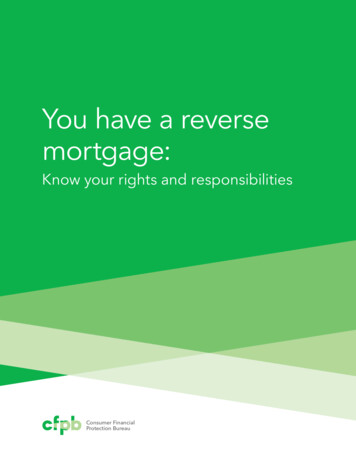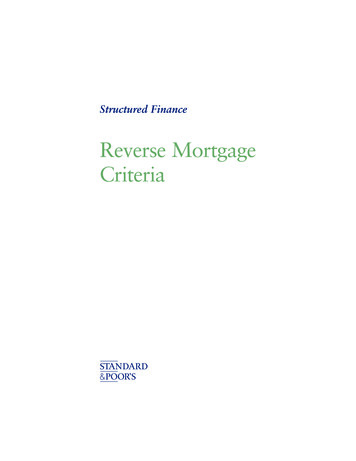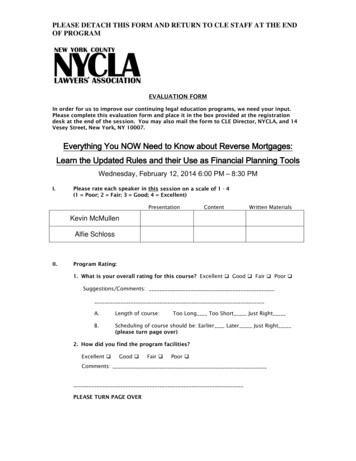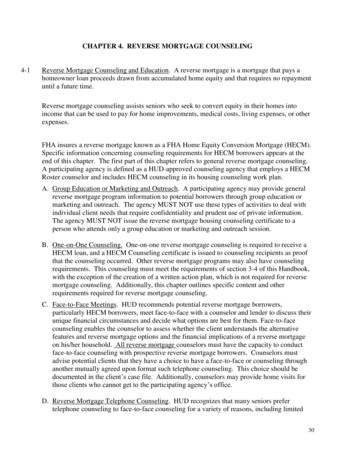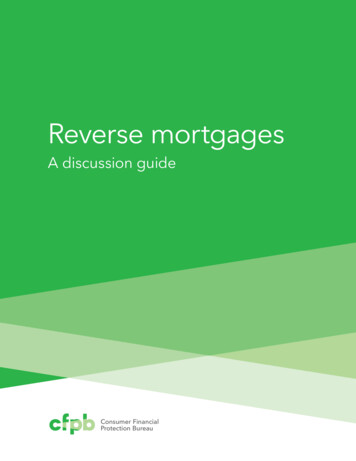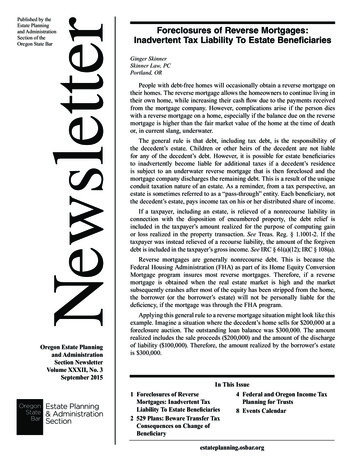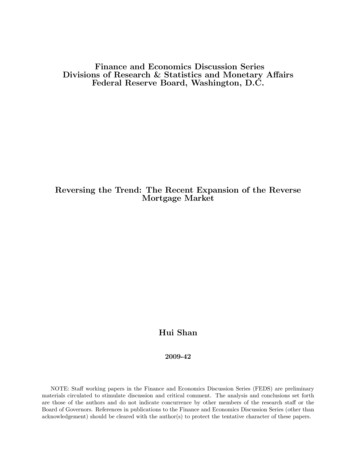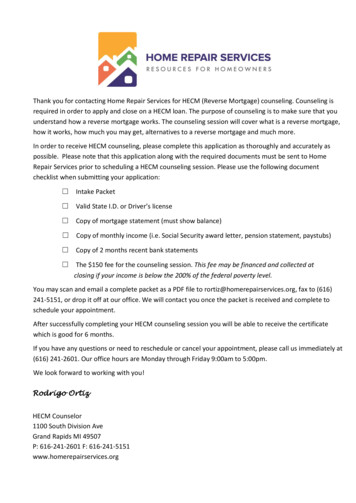
Transcription
Discussion PaperReverse Mortgage Retrospective:How Recent Policy ChangesAffected Government-InsuredReverse Mortgage Originations andPerformanceLauren Lambie-HansonFederal Reserve Bank of PhiladelphiaConsumer Finance InstituteStephanie MoultonOhio State University andFederal Reserve Bank of PhiladelphiaConsumer Finance Institute Visiting ScholarDP 20-06November 2020https://doi.org/10.21799/frbp.dp.2020.06
Reverse Mortgage Retrospective: How Recent Policy Changes AffectedGovernment-Insured Reverse Mortgage Originations and PerformanceLauren Lambie-Hanson*Federal Reserve Bank of PhiladelphiaStephanie MoultonOhio State UniversityNovember 2020AbstractThis discussion paper analyzes the outcomes of recent policy reforms to the federally insuredreverse mortgage program. Prior to these reforms, more than one out of 10 older adults with aHome Equity Conversion Mortgage (HECM) was reported to be in default on the loan for failureto pay property taxes or homeowner’s insurance payments. We study the effect of two majortypes of policy reforms: one that restricted the amount of funds available to a borrower, and theother that introduced underwriting requirements through a financial assessment for the first timein the program’s history. Our primary data set includes HECM loans originated between 2012and 2015, with monthly loan performance through May 2019. We observe a significant reductionin the three-year rate of tax and insurance default before and after the policy reforms, from 8.7%to 2.2%. However, some of this reduction is offset by a corresponding increase in lenderpayment of these expenses out of a borrower’s line of credit. We also observe that about twothirds of HECM borrowers are fully drawn on their line of credit within three years oforigination, placing those with unscheduled draws at risk of future default. In addition to changesin default and draw behavior, policy reforms during this time period slowed the speed at whichHECM borrowers could withdraw equity and reduced the total amount of equity that can bewithdrawn by the borrower. We document these facts and discuss implications for policy.Keywords: reverse mortgages, Home Equity Conversion Mortgage, mortgage default, propertytaxes, homeowner insuranceJEL codes: G21, G28, G51*Lauren Lambie-Hanson is an advisor and research fellow at the Federal Reserve Bank of Philadelphia’s ConsumerFinance Institute: lauren.lambie-hanson@phil.frb.org. Stephanie Moulton is an associate professor of the Ohio StateUniversity’s John Glenn College of Public Affairs: moulton.23@osu.edu. The authors thank Joshua Miller andJosephine Stangle of the U.S. Department of Housing and Urban Development for helpful comments.Disclaimer: This Philadelphia Fed Discussion Paper represents preliminary research that is being circulated fordiscussion purposes. The views expressed in these papers are solely those of the authors and do not necessarilyreflect the views of the Federal Reserve Bank of Philadelphia, the Federal Reserve System, or the U.S. Departmentof Housing and Urban Development. Nothing in the text should be construed as an endorsement of any organizationor its products or services. No statements here should be treated as legal advice. Any errors or omissions are theresponsibility of the authors. Philadelphia Fed discussion papers are free to download titute/publications.
I. IntroductionAs of February 2012, nearly one out of 10 older homeowners with a federally insured reversemortgage was in default for failure to pay property taxes or homeowner’s insurance (ConsumerFinancial Protection Bureau (CFPB), 2012). Although only a small share of Home EquityConversion Mortgage (HECM) borrowers who default ultimately wind up in foreclosure,defaults still trigger costly loss mitigation for servicers and can ultimately pose a drain on theHECM insurance fund. This motivated Congress to pass the Reverse Mortgage Stabilization Actin 2013, which authorized U.S. Department of Housing and Urban Development (HUD) todesign and enact a series of policy changes intended to reduce default and shore up the program.By April 2020, industry analysts reported the overall serious default rate for loans originatedafter the policy changes to be 75% lower than loans originated prior to the policy changes,providing preliminary evidence that the policy changes were a success (New View Advisors,2020). But these policy changes also come with tradeoffs, restricting the amount of home equitythat can be borrowed and the speed at which it can be withdrawn. It is thus important to takestock of how these policy changes affected both access and performance in the HECM program.This is the goal of this discussion paper.Reverse mortgages are loans made to older homeowners with no expected repaymentuntil the borrower exits the home, typically at the time of death. Unlike a traditional forwardmortgage in which the balance declines as borrowers make monthly payments, the balance on areverse mortgage grows over time with the accrual of interest and fees. In the U.S., most reversemortgages are insured by the federal government through the HECM program. 1 Federalinsurance on reverse mortgages through the Federal Housing Administration (FHA) mutualmortgage insurance fund (MMI) protects borrowers and lenders from negative equity. 2There is a small but growing market of non-HECM proprietary reverse mortgages. Proprietary reverse mortgagesare most common among high-value properties that exceed the property value limits for a HECM, which was 765,600 in 2020. As of 2019, proprietary reverse mortgages comprised less than 10% of all originations but 25% ofthe total dollar value of reverse mortgage originations (Mayer and Moulton, 2020).1Prior to loan termination, borrowers still have access to available proceeds on the HECM even if the loan balancegrows to exceed the value of the home. When the HECM loan terminates, borrowers or their heirs may purchase thehome for the lesser of the outstanding balance on the HECM or 95% of the current appraised value. If the sales priceof the home is less than the current appraised value, the lender may file a claim to HUD for the loss of up to themaximum claim amount (typically equal to the appraised value at the time of the HECM origination), as long as theloan is in good standing.21
Reverse mortgages can be an important source of liquidity for the growing share of olderadults with a substantial portion of their wealth tied up in the equity in their homes (Goodman etal., 2017; Moulton and Haurin, 2019). Reverse mortgages can also play a countercyclical role inproviding access to home equity when other channels of mortgage borrowing are constrained.For example, uncertainty regarding home values and income shocks associated with the COVID19 pandemic led many large banks to halt originations of home equity loans and home equitylines of credit (Lerner, 2020), contributing to elevated volumes of HECM originations during thepandemic (Clow, 2020).Despite their benefits, reverse mortgages also carry risks — to homeowners, lenders, thefederal government, and taxpayers. While there is no monthly payment for reverse mortgageborrowers, they are required to occupy the home as a principal residence, keep up with requiredrepairs, pay property taxes, and maintain homeowner’s insurance. If a borrower fails to meetthese obligations, the loan is considered to be in “technical default,” triggering a series of actionsthat in the most extreme cases can result in foreclosure. The loan servicer must resolve thedefault to avoid losses that would otherwise be covered by federal insurance, either throughworking out a repayment plan with a borrower or foreclosing on the property. 3 HECMs that endin default-related foreclosures sell for substantially less than nondistressed terminations, oftenincurring large draws against the FHA mortgage insurance fund (Begley et al., 2019; CBO,2019). Property tax and insurance defaults are costly for all parties involved.The policy reforms enacted between 2013 and 2015 were intended to reduce the risk ofdefault and the probability of large draws against the FHA mortgage insurance fund. Asannounced by then-Federal Housing Commissioner Carol Galante, “Our goal here is to makecertain our reverse mortgage program is a financially sustainable option for seniors that willallow them to age in place in their own homes” (U.S. Department of Housing and UrbanDevelopment, 2013). The first set of policy changes restricted the amount of home equityavailable to HECM borrowers and slowed the rate at which they could withdraw funds. Thesecond major policy change required a financial assessment of a homeowner’s income andcredit. Homeowners failing the financial assessment can still receive a HECM if they can setLoss mitigation requirements are detailed in a series of mortgagee letters issued by HUD, including MortgageeLetters 2015-11 and 2016-7, available online at https://www.hud.gov/sites/documents/15-11ML.PDF .32
aside enough equity in an escrow account to pay for future property taxes and insurancepayments, or if they have other compensating factors.In this paper, we explore the varying effects of these policies using HECM originationand performance data from HUD from December 2012 to May 2019. We focus on a subsampleof 116,000 borrowers with loans originated immediately before and immediately after each ofthe policy changes from 2013 through 2015, following each loan’s performance for the 36months after it was originated. Our empirical strategy assumes that the relative timing of thepolicy changes within our narrow timeframe may be considered exogenous to a borrower’sdecision to default. Based on this assumption, we compare simple differences in mean outcomesbefore and after each policy change.We find a significant reduction in the three-year rate of tax and insurance (T&I) defaultbefore and after the policy reforms, from 8.7% to 2.2%. However, some of this reduction isoffset by a corresponding increase in unscheduled lender payments of these expenses out of aborrower’s line of credit. This reliance on the line of credit may not be sustainable over the longterm, given that over 40% of HECM borrowers have exhausted their line of credit within 13months of origination, and nearly two-thirds have exhausted their line within 36 months.Optimistically, post the financial assessment, our results show a reduction in both default andunscheduled draws from the line of credit to pay for T&I. This more targeted policy change toidentify at-risk borrowers and create an intentional set-aside to cover future expenses may bemore effective in the long run than across-the-board reductions to accessible home equity.We show that borrowers who use their HECM proceeds to pay off existing forwardmortgage debt are more likely to experience T&I default. This is likely attributable to a selectioneffect because these borrowers are more highly leveraged, but it is also attributable to a treatmenteffect: These borrowers are not subject to the same draw restrictions at origination. If they wish,they are able to extract all their available line of credit at closing. If they do so, no funds areavailable to cover taxes and insurance if needed, leading these borrowers to be at greater risk ofdefault.In addition to reducing default, HUD’s policy changes from 2013 through 2015 loweredthe amount of equity the typical new HECM borrower can extract. Draw restriction changes in2013 slowed the rate at which borrowers could withdraw their equity, while other changes inprincipal limit factors affected the total amount that could be withdrawn over the life of the loan.3
We show that a typical borrower who takes out a HECM today could access over the life of theloan only about 70% of the home equity that was available prior to the policy changes.In the next section, we provide background on the HECM program and the policychanges designed to improve the program’s solvency. In Section 3, we discuss the data andcompare the characteristics of borrowers who took out new HECMs before and after the policychanges. In Section 4, we examine changes in loan performance before and after each policychange, including T&I defaults as well as unscheduled draws to pay for T&I. In Section 5, wedescribe the effects of the policy changes on the amount of home equity available tohomeowners under a HECM and explore changes in draw behaviors before and after the policychanges. In Section 6, we summarize our key findings and suggest avenues for future research.II. Background2.1 HECM BasicsNearly 1.2 million federally insured HECM loans have been originated since the program’sinception in late 1989 through July 2020, with only about 2% of the eligible population ofhomeowners age 62 and older holding a reverse mortgage at a given point in time (Moulton andHaurin, 2019). Figure 1 graphs the number of HECM endorsements by month over time.Figure 1. HECMs Endorsed by HUD, January 1990–July 2020Note: Displays loans by date of endorsement, which is usually within one to three months of the loan closing.Source: Authors’ tabulations of publicly available U.S. Department of Housing and Urban Development SingleFamily Portfolio Snap Shot data4
HECMs allow older adults to liquefy a portion of their home equity. The amount ofmoney a person can get from a HECM typically ranges between 40% and 75% of the value oftheir home, depending on a borrower’s age and the expected interest rate on the loan. 4 HUD setsthe maximum loan-to-value (LTV) ratio — called the principal limit factor — at the originationof a HECM, so that it is higher for older borrowers and higher when interest rates are lower. Thislimit is set to reduce the risk that the balance on the HECM loan will grow to exceed the value ofthe home over time. HUD also sets a maximum property value called the maximum claimamount. As of January 1, 2020, this limit was 765,600. If a homeowner’s property value is inexcess of the limit, she can still get a HECM, but the maximum LTV is as a proportion of thelimit rather than the home’s value.HECM borrowers can receive money in a variety of ways. First, borrowers can take out alump sum of money up front as cash or to pay off other debt, including any forward mortgagedebt held by the borrower as the HECM can be the only mortgage on the property. About half ofall HECM borrowers use at least a portion of the proceeds to pay off a forward mortgage(Moulton, Loibl, and Haurin, 2017). Converting forward mortgage debt into reverse mortgagedebt frees up cash flow for the homeowner by eliminating the burden of the monthly mortgagepayment.After repaying forward mortgage debt and withdrawing desired cash up front, mostHECM borrowers structure remaining available HECM funds as a line of credit — similar to ahome equity line of credit (HELOC). The amount of money remaining on the line of creditgrows at the same rate as the balance on the loan, corresponding to the interest rate and monthlyfees. This growth feature of the line of credit has been promoted as a benefit of HECMs byfinancial planners and brokers (Hopkins, 2017; Pfeiffer and Evensky, 2012), as the growth is nottied to the underlying value of the home. Locking in a HECM line of credit at today’s homevalue plus the expected growth rate can thus serve as a hedge against future house price risk. Analternative structure is to take some or all of the HECM funds as a scheduled monthlydisbursement, similar to an annuity, for either a set term (e.g., 10 years) or for the borrower’sremaining life. From 2011 through 2019, only about 6% of HECM borrowers chose to structureEstimates based on an expected rate of 5% for a 62-year-old borrower and 99-year-old borrower, respectively,using the principal limit factors effective on and after October 2, 2017; seehttps://www.hud.gov/program offices/housing/sfh/hecm.45
even a portion of their HECM proceeds as an annuity-like monthly tenure or term payment(Pinnacle, 2019).Figure 2 provides a stylized example of how a HECM balance grows over time relative tofunds remaining on a line of credit and the value of the home. In this example, the borrower is a72-year-old widow with a home value of 270,000 when she closes on a HECM loan on January1, 2020. At that time, based on her age and an expected annualized interest rate of 3%, hermaximum LTV is 59.5%, or 160,650 in drawable home equity. She had an existing homeequity loan balance of 50,000 that she was required to pay off with the HECM, as the HECMcan be the only lien on the property. She also rolls the 5,500 in closing costs and 5,400 upfront mortgage insurance premium into the loan balance. This brings her initial loan balance to 60,900 at the time of origination, with a remaining line of credit of 99,750.Figure 2. Example of Funds Available to a Typical BorrowerSource: Authors’ tabulations of data from the U.S. Department of Housing and Urban DevelopmentThe balance and the line of credit on the HECM grow at a rate equal to the interest rateplus an annualized 0.5% mortgage insurance premium, paid monthly. Assuming the adjustableinterest rate remains at 3%, the balance on the loan will grow at an annualized rate of 3.5%, orabout 0.29% per month. In 10 years, if she does not make any additional draws on the line ofcredit, as shown in the left panel, the loan balance will grow to 86,377, and the amountavailable to draw on the line of credit will grow to 141,480. On the other hand, as shown in theright panel, if she draws the remaining available money on the line of credit after the first year,6
by the time she is 82, the balance on the loan will grow to 227,857, with no remaining equity onthe line of credit.Assuming house prices continue to appreciate at a rate of 2% per year as they have beennationally in recent years, the balance on her HECM loan should not grow to exceed the value ofher home during her expected lifetime in either scenario. However, if the value of her home wereto drop by 16% or more by the time she turns 82 — either because of an economic downturn orif her home depreciates in value because of lack of maintenance or other idiosyncratic factors —the balance on her HECM loan could grow to exceed the home value. In these cases, the federalmutual mortgage insurance fund typically assumes the loss. While crossover risk appears to be alow probability event in the current market environment, this was not uncommon during theGreat Recession when house values decreased by as much as 50% to 60% in some states(CoreLogic, 2018). This contributed to large projected losses to the FHA mutual mortgageinsurance fund, with a projected 9.5 billion deficit in net worth for the HECM portion of thefund in 2019 (Pinnacle, 2019). 5There are two primary policy levers that HUD uses to reduce the risk of losses to thefederal insurance fund. The first is to lower the maximum LTV (principal limit factor) at the timeof origination so the probability that the balance exceeds the value of the home over time isreduced. The second is to set the amount of the up-front and monthly mortgage insurancepremiums high enough to offset any losses to the federal insurance fund. Both of these policylevers have been used multiple times since the Great Recession. The principal limit factor wasadjusted three times between 2013 and 2017, significantly affecting the amount of home equityavailable through a HECM. 6 The mortgage insurance premiums were adjusted twice during thesame period, with the current premium being 2% of the maximum claim amount at the time oforigination, and 0.5% of the balance monthly through the life of the loan. 7 These premiumsProjected losses (or gains) to the HECM portion of the mutual mortgage insurance fund have been extremelyvolatile over time, in part because of the uncertainties associated with HECMs, such as the term of the loan and theexpected home value and loan balance at the time of loan termination. Different assumptions about theseuncertainties, such as default rates and future home values, can substantially influence projected losses. Further,actuarial estimates may fail to account for the extent to which newer HECM cohorts will perform better than HECMcohorts prior to the 2013‒2015 policy reforms. Housing policy experts have advocated for the HECM portion of theMMI fund to be separated from the forward portion of the FHA MMI fund in part because of these complexities(Golding and Goodman, 2017).56See Mortgagee Letters 2013-27, 2014-12, and 2017-12.7See Mortgagee Letters 2013-27 and 2017-12.7
contribute to the perceived high costs of HECMs compared with traditional mortgage loans, yetthey also protect borrower and their heirs from negative equity.2.2 Default in the HECM ContextHECM borrowers are typically not required to repay their mortgage balance until they die or nolonger live in the property as their primary residence. However, a HECM is called “due andpayable” if the borrower defaults on the obligations of the loan related to occupancy,maintenance, property taxes, or insurance payments. When a HECM is called due and payable,the borrower is required to repay the balance (often through home sale or foreclosure) or workout a repayment plan with the lender. In a report to Congress, the U.S. GovernmentAccountability Office (GAO) estimated that, while the majority of HECM terminations were dueto death or relocation of the borrower, about 15% of the 272,155 HECM loans terminatedbetween 2015 and 2018 were terminated because of default. Of the default related terminations,the majority (73%) were due to occupancy violations, with 27% because of delinquent propertytaxes or homeowner’s insurance, and less than 1% because of maintenance violations (GAO,2019).Not all defaults result in terminations, and not all cases of missed property tax andinsurance payments result in default. Each year, HECM borrowers are required to submitdocumentation to their lender showing proof of homeowner’s insurance and a certificate ofoccupancy indicating they lived in the property at least six months of the year. With regard toproperty taxes, the lender verifies with the taxing jurisdiction that borrowers are up to date onproperty taxes. If a borrower fails to provide proof of homeowner’s insurance or has not paidproperty taxes to the taxing jurisdiction, the lender notifies the borrower. The lender thenpurchases force-placed homeowner’s insurance or pays the property taxes on behalf of theborrower. If the borrower has money remaining on the HECM line of credit, these expenses arepaid out of the line of credit as an “unscheduled draw.” If the borrower does not have moneyremaining on the line of credit, the lender adds the expenses to the balance of the loan.Adding property taxes and homeowner’s insurance expenses to the balance of a loan thatis already fully drawn accelerates the growth in the balance and therefore the risk that thebalance will exceed the value of the home. This creates additional losses to the governmentinsurance fund when the HECM eventually becomes due. Beginning in 2011, HUD issued a8
series of mortgagee letters requiring lenders to report borrowers who were in default on theirtaxes or insurance and to recoup funds that were advanced by the lender, either through arepayment plan with the borrower or foreclosure. 8 Failure to take such actions would result in aHECM being ineligible for assignment to HUD, increasing exposure of the lender to potentialfinancial loss. However, foreclosing on HECM borrowers for past-due property taxes orinsurance presented a substantial reputational risk to lenders. Tax and insurance defaults werecited as one of the primary reasons Wells Fargo exited the HECM market in 2011. 9 Alternativeswere needed to reduce the risk of tax and insurance default in the HECM program.2.3 Reducing HECM Tax and Insurance (T&I) DefaultsA HECM is only considered to be in default for property taxes or homeowner’s insurance if twoconditions are satisfied: (1) the borrower fails to pay property taxes or maintain homeowner’sinsurance, and (2) the borrower is out of funds on the HECM line of credit. Policies to reducedefault can target either condition. The first set of policy changes were structural, designed toslow the rate of spend-down from the line of credit. These changes were intended to not onlyreduce T&I defaults, but also to reduce the probability that HECMs would end up underwaterand require large draws from the federal insurance fund. The second set of policies targetedborrower capacity to pay taxes and homeowner’s insurance and introduced risk-basedunderwriting for the first time in the program’s history.Draw RestrictionsHECMs are typically structured as adjustable-rate mortgages (ARMs) because of the open-endednature of the loan and uncertainty about the amount and timing of future draws. In 2009, analternative fixed-rate HECM entered the market. To offset the uncertainty of future draws, thefixed-rate product was structured as a closed-end loan, with any funds borrowed to be drawn atThe specific HUD policies regarding technical defaults have changed over time, beginning in 2011 (MortgageeLetter 2011-1). As of April 23, 2015 (Mortgagee Letter 2015-11), lenders are required to call a loan “due andpayable” if funds are advanced by the lender on behalf of the borrower to pay past due property taxes orhomeowner’s insurance. After a loan is called due and payable, the lender must initiate the foreclosure process if theborrower is unable to repay the HECM loan balance in full (e.g., through home sale). If the borrower enters arepayment plan, the lender can request an extension to the foreclosure timeline. For details, see Mortgagee Letter2016-7, ee semortgage-business/.99
the time of origination. Investors preferred the fixed-rate option because of reduced drawuncertainty and were willing to pay a higher premium to purchase securities of fixed-rateHECMs. A portion of this higher premium was often passed on to the borrower in the form ofwaived origination costs, making the fixed-rate HECM a more attractive option for borrowersthan adjustable-rate HECMs.The fixed-rate HECM quickly became the dominant type of reverse mortgage, with 70%of borrowers choosing this option by 2010. A drawback of the fixed-rate HECM, however, wasthat it required borrowers to withdraw all of their available funds up front, leaving no remainingmoney on a line of credit for future draws. If borrowers failed to pay their property taxes orinsurance, they were immediately in default with no money on the line of credit to cover theseexpenses. On January 1, 2013, HUD issued a mortgagee letter that limited the origination offixed-rate, full-draw HECMs to the “saver” version of the product that had a lower LTV atorigination. 10 In September 2013, HUD eliminated the saver version of the product altogetherand limited HECM withdrawals to 60% of available funds in the first year unless a higheramount was needed to pay off a forward mortgage. 11 Shortly after these changes, alternativefixed-rate products emerged that circumvented the policies, requiring a full draw after one yearor allowing future draws with considerable interest rate risk. In June 2014, HUD announced thatit would no longer insure fixed-rate HECMs that allowed for future draws or that did not complywith the up-front draw limits. 12Financial AssessmentIn parallel to the structural changes to the HECM program, HUD introduced new financialassessment criteria to determine borrower eligibility for a HECM. While the financial assessmentwas first announced in September 2013 with the up-front draw limits, the implementation wasdelayed until April 2015. 13 Prior to the financial assessment, eligibility for a HECM was basedentirely on the characteristics of the property and not the borrower, other than being age 62 orolder. Similar to underwriting for traditional mortgages, the financial assessment evaluates a10See HUD Mortgagee Letter 2013-01, See HUD Mortgagee Letter 2013-27, See HUD Mortgagee Letter 2014-11, e HUD Mortgagee Letter 2015-06, https://www.hud.gov/sites/documents/15-06ML.PDF; Revised FinancialAssessment Guide, PDF.1310
borrower’s credit history and residual income to determine a borrower’s capacity to pay futureproperty taxes and homeowner’s insurance.Table 1 provides a summary of the financial assessment requirements. If a prospectiveborrower fails to meet the requirements, she may still take out a HECM but must set asidesufficient funds from the proceeds of the HECM to pay future property taxes and homeowner’sinsurance. 14 This life expectancy set aside (LESA) is essentially a “carve out” from the HECMproceeds and is projected to grow at the same rate as the line of credit. Only funds drawn fromthe LESA to pay for property taxes or homeowner’s insurance are added to the balance of theloan. When the HECM terminates, the outstanding balance is repaid with any unused equityavailable to the borrower or his or her heirs. According to our analysis of HUD data, in the sixmonths after the policy took effect, 16% of new HECM borrowers had a LESA, and the medianvalue of their accounts was nearly 31,000.Table 1. HECM Financial Assessment CriteriaCriteriaCredit and Payment HistoryRent, mortgage, and non-housinginstallment debtRevolving debt (e.g. credit cards)Collections, charge-offs, judgments anddelinquent federal debtChapter 7 and Chapter 13 bankruptcyProperty taxes and property chargesExtenuating circumstancesResidual Income AnalysisResidual
There is a small but growing market of non-HECM proprietary reverse mortgages. Proprietary reverse mortgages are most common among high-value properties that exceed the property value limits for a HECM, which was 765,600 in 2020. As of 2019, proprietary reverse mortgages comprised less than 10% of all originations but 25% of the total dollar .
